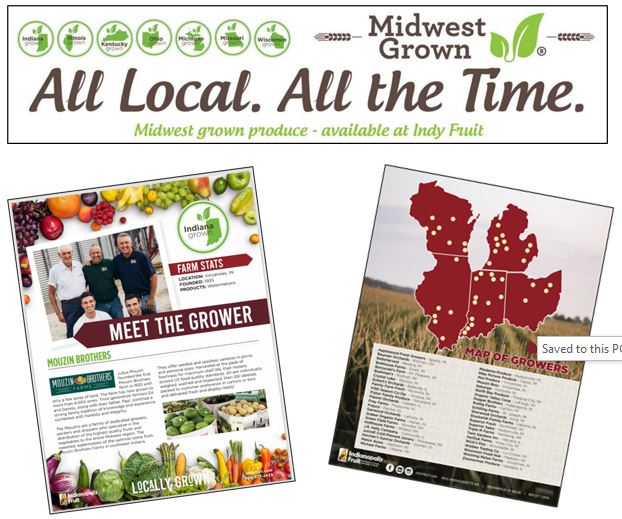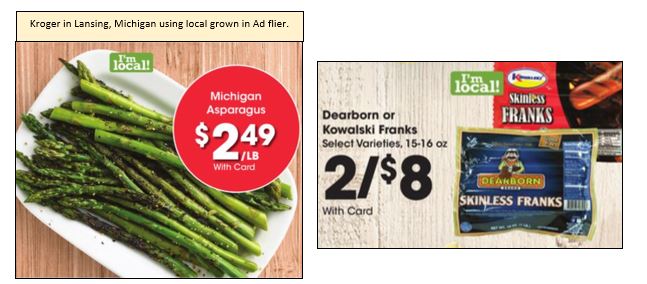For reasons that everyone can understand, healthier living is at the top of the collective to-do list for 2021. For many folks, that list also includes supporting the community and the retailers that helped them get through the tough times of the last year. Buying local fruits and vegetables is a way for consumers to check all those boxes.
Here are some important considerations to give local this season and throughout the year.
Defining local
For some retailers, local means grown within their state. For others, it means product is grown within a certain number of miles. Some retailers designate products from neighboring states as part of their local assortment. Others target hyperlocal, with a unique assortment for each store.
The choice is up to each organization, and the factors in the decision include geography, history and overall company commitment to supporting local.
For merchants that operate multiple stores across many different states, using local and hyperlocal programs in tandem seems to be a perfect combination. This approach allows the leadership team to focus on procuring the heavier-tonnage, primary local items while leaving the smaller-volume hyperlocal items for the store teams to procure.
Logistics of local
Procuring local has many hidden benefits for customer and retailer. First and foremost, procuring local means fewer transit miles, less pollution and less fuel cost. All three factors have a positive impact for the environment and bottom line.
Secondly, procuring local items gives the buying team shorter ordering lead times and quicker delivery options. Both factors help the supply chain keep inventory levels turning faster and fulfillment rates high, and ultimately they result in fresh product for the consumer.
Many local growers provide both options for product transportation to the retailer: direct store delivery or delivery into the retailer's distribution center. Each approach has its benefits, depending on the type of product and the volume of product.
The two commodities that always make me lean toward direct store delivery when possible are heavy watermelon bins and bulky corn pallets. Both of these commodities represent large tonnage and weight concerns that have the potential to clog up distribution center slots and outbound delivery truck space. Once you weigh the cost of receiving, slotting, rotating, selecting and re-loading items like watermelon and corn, it will probably be advantageous to negotiate a lower direct store delivery cost with the supplier.
Smaller, lower-volume, local items like microgreens or fresh herbs might also be better suited for direct store delivery. This allows the grower to provide each store with the freshest possible product because it eliminates the possibility of it getting lost or aged in a retailer's distribution center.
Local supplier requirements
Local is all about partnerships. Planning for the local season needs to be a team effort between grower and retailer. Discussions on assortment and tonnage need to start at least six months prior to the season starting. For example, January usually is the planning period for retailers that have a primary local season starting in June or July.
Just because the product is grown locally does not mean that retailers can forget about food safety. Every retailer should have a transparent supplier approval program.
This program needs to outline what the prerequisites are for conducting business. USDA and FDA documentation is important to have on file. Proof of organic and non-GMO certifications is also critical.
Listed below are some additional requirements and questions to consider for your supplier approval program.
- Certificate of insurance with a minimum dollar amount required.
- Supplier tax ID information (W9 Form).
- Current grower facility food safety certification and credentials. Examples include HACCP, SQF, BRC, IFS, FSSC, GLOBALG.A.P., BAP and Non-GMO certification.
- Estimated weekly volume available by item – case quantity, pallet quantity or load volume quantity.
- Minimum order amount(s) from the supplier.
- Order lead time for placing purchase orders and receiving orders.
- Method of product delivery for refrigerated items shipped direct store delivery or directly into a distribution center.
- Ability to deliver to stores for full-service direct store delivery programs.
- Does bulk commodity product include PLU stickers, bands or ties?
- Does packaged product include UPC scan bar?
- Are all products hydrocooled or forced-air cooled to proper temperatures?
- Can grower provide weekly costs, along with start and end dates for each item?
- Does grower meet government guidelines for traceability?
Assortment and merchandising
Customers love and appreciate local. Whenever possible, err on the side of only carrying local items while they are in season and available. Of course, quality, availability, grower service levels and costs should always be considered when deciding if a local item is a good fit for your assortment.
Additional display space for many local items is a must-have. Customers need a big and bold local display to grab their attention. Vibrant color breaks, local signage and the use of “farmers market” display props all contribute to creating customer interest and ultimately selling more incremental products. Wooden crates, bushel baskets and grower-labeled boxes used to display product help set the local tone.
Local fruits and veggies benefit from being paired with other local or artisan products within the store. Cross-merchandising local fruits and veggies with items like local honey, jams, cheeses, olive oils and fresh-baked breads helps customers feel the local atmosphere and season.
It also helps make a more significant impact with customers when they see large amounts of local items displayed together. Cross-merchandising local products is most effective when done at the entrance of the store or in high-traffic, focal, end-cap positions.
Weather permitting, merchandising local fruit and veggies on the outside patio of the store is also a great way to create a feeling of fresh and local. Local melons, tomatoes, squash and onions are customer favorites when merchandised outside the store. They are also durable items that hold up well in average outdoor temperatures.

Local assortment example at Whole Foods in Tucson, Ariz.
Promoting local
If you're carrying a great local assortment, you should take every opportunity to talk about it – shout it from the rooftops!
This is where your marketing team comes in. They can create local signage, call out local in the ad fliers, promote local on the website and make local a feature on the organization's social media feeds.
One of my favorite examples of a stellar local marketing program comes from the folks at Indianapolis Fruit, distributors of many Midwest fruits and vegetables. The team there has put together an all-inclusive marketing program that includes local signage and educational point-of-sale material that drives maximum customer awareness of the local grown items.
I particularly like the “Meet the Grower” signage that helps show customers the actual farmers, farm locations and items being grown. Indianapolis Fruit has also done a great job differentiating local items from seven different states by creating an icon for each one. All the local growers used by Indianapolis Fruit have their location and name of farm well identified on a map that can be used for in-store signage or customer viewing on the retailer's website.

Promotion of local items in the ad flier should be congruous in design with the in-store signage and point-of-sale material. If you are using a local badge, button or logo on signage, it should also be used in the ad flier, on the website and on social media. See below where Kroger uses the “I'm local!” button in their ad flier and on their in-store signage. They also title the item with the state name. In this case, Michigan asparagus is being promoted at the company's Lansing, Mich., store location.

Pricing strategy for local
Some local products provide the retailer with a transportation cost savings. Many other local grown products do not offer a cost-of-goods savings, mostly due to lacking economies of scale from seasonal farming.
Retail pricing decisions for local become challenging when costs for local items are higher than current market value of product grown elsewhere. Although most customers prefer to support local, many are not willing to pay more for local products. Creating a “value” pricing strategy for local usually ends up being the best way to keep product moving and customers happy.
You do not have to give away local with below-margin budget retails, but you cannot offend customers either with sticker-shock price points. Most of the time, local seasonal items make up a small percent of the total department sales and profits, making it easy on the bottom line to use the fast-nickel, lower retail price point approach.
Local items that are grown in mass quantities make excellent promotional opportunities. Michigan blueberries, Georgia peaches, Colorado corn and Indiana watermelons are all great examples of local commodities that make great feature items in the ad flier.
When the stars align and all local items in your growing region are in season together, use the front page of the ad flier to make a local statement with multiple items. Primary feature items should be aggressively priced, while secondary items can be featured at or slightly below everyday low prices.
Local fruit and vegetable potential for 2021
Now more than ever, consumers are looking for healthier eating solutions that support their community. The local factor will be a criteria for many shoppers this season.
Lowering fuel usage, creating less pollution, reducing the carbon footprint and supporting local farms and families will be in the thoughts of many hungry shoppers.
Providing them with fresh, local fruits and vegetables that taste better – due to more time in the field to fully ripen versus lengthy amounts of time in transit or in someone's warehouse – will also create greater customer loyalty for the retailer. Local can be a win-win proposition when it is planned and executed at the highest level.
Scott Schuette is a produce retail veteran of more than 35 years and was most recently the vice president of produce and floral for Fresh Thyme Market. He has been named Produce Retailer of the Year and Specialty Food Retailer of the Year over the course of his decades of service to the fresh produce industry.












